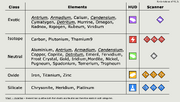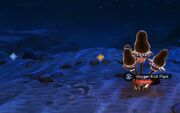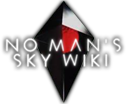Resources are the primary materials for multi-tool, starship, and exosuit upgrades.
Summary
Resources in No Man's Sky are organized in a periodic table custom made for the game. When resources are mined, they are broken down into their chemical elements, and these can be combined into new products, resources, etc. and sold on the open market.
Technology is dependent on certain elements, so collecting element resources and alloys can unlock new multi-tools, starships, etc.
Resources can be obtained in a wide variety of ways. They can be purchased, mined from raw elements on the ground of planets (either by hand or with an AMU), mined from asteroids in space, harvested from plants, given to you as gifts from animals you befriend, found in crates and containers on planet surfaces, and harvested by killing plants or animals or mining mineral formations. The abundance of elements varies significantly from one planet to another, and some resources are easiest to obtain in specific ways.
Scanning

Scanner and HUD icons

Scanner "diamonds"
When the scanner is used on a planet, diamonds of red, yellow, blue, green, and purple are displayed after the scan. These colors represent the location of elements belonging to the element groups indicated below. Resources of common rarity will not have the diamond markers. All mineable nodes (chunks of minerals in rock form) will have grids outlining the parts that will give resources when mined. Nodes that do not have grids DO NOT give resources when mined.
Elements
There are five groups of elements: Oxides, Isotopes, Silicates, Neutrals, and Exotic elements. There are also four elements that are members of the Neutral/Exotic elements family that show characteristics of both the Neutral and Exotic groups.
The following table contains:
- 19 elements present in the initial release
- 14 elements added as part of Update 1.10 (Foundation)
- 2 elements added as part of Update 1.2 (Pathfinder)
It does not contain alloys or other crafted products. (A list of alloys follows this table.)
| Icon | Element | Abbrev | Group | Rarity | Base value units | Released |
|---|---|---|---|---|---|---|
 |
Iron | Fe | Oxide | Common | 13.8 | 1.0 |
 |
Zinc | Zn | Oxide | Uncommon | 41.3 | 1.0 |
 |
Titanium | Ti | Oxide | Rare | 61.9 | 1.0 |
 |
Heridium | Hr | Silicate | Common | 27.5 | 1.0 |
 |
Platinum | Pt | Silicate | Uncommon | 55 | 1.0 |
 |
Chrysonite | Ch | Silicate | Rare | 82.5 | 1.0 |
| File:Substance.fuel.common1.png | Carbon | C | Isotope | Common | 6.9 | 1.0 |
 |
Thamium9 | Th | Isotope | Uncommon | 20.6 | 1.0 |
 |
Plutonium | Pu | Isotope | Rare | 41.3 | 1.0 |
 |
Nickel | Ni | Neutral | Common | 137.5 | 1.0 |
 |
Iridium | Ir | Neutral | Uncommon | 96.3 | 1.0 |
 |
Copper | Cu | Neutral | Uncommon | 110 | 1.0 |
 |
Gold | Au | Neutral | Rare | 220 | 1.0 |
 |
Aluminium | Al | Neutral | Rare | 165 | 1.0 |
 |
Emeril | Em | Neutral | Rare | 275 | 1.0 |
| File:Substance.neutral.rare7.png | Fervidium | Fr | Neutral | Rare | 165.0 | 1.10 |
| File:Substance.neutral.rare15.png | Mordite | Mo | Neutral | Rare | 13.8 | 1.10 |
| File:Substance.neutral.rare5.png | Pugneum | Pg | Neutral | Rare | 137.5 | 1.10 |
| File:Substance.neutral.rare4.png | Spadonium | Sp | Neutral | Rare | 178.8 | 1.10 |
 |
Tropheum | Tr | Neutral | Rare | 137.5 | 1.10 |
| File:Substance.neutral.rare11.png | Temerium | Te | Neutral | Rare | 178.8 | 1.10 |
| File:Substance.neutral.rare13.png | Coryzagen | Co | Neutral | Rare | 158.1 | 1.10 |
| File:Substance.neutral.rare14.png | Coprite | Cr | Neutral | Rare | 6.9 | 1.10 |
| File:Substance.neutral.rare3.png | Antrium | An | Neutral/Exotic | Rare | 41.3 | 1.10 |
| Armadium | Ar | Neutral/Exotic | Rare | 27.5 | 1.2 | |
| File:Substance.neutral.rare8.png | Candensium | Cn | Neutral/Exotic | Rare | 171.9 | 1.10 |
| File:NmsResource Detritum Icon.jpg | Detritum | De | Neutral/Exotic | Rare | 27.5 | 1.2 |
| File:Substance.neutral.rare9.png | Rigogen | Ri | Exotic | Rare | 41.3 | 1.10 |
 |
Rubeum | Ru | Exotic | Rare | 288.8 | 1.10 |
 |
Viridium | Vi | Exotic | Rare | 302.5 | 1.10 |
 |
Omegon | Om | Exotic | Very Rare | 309.4 | 1.0 |
 |
Radnox | Ra | Exotic | Very Rare | 302.5 | 1.0 |
 |
Murrine | Mu | Exotic | Very Rare | 302.5 | 1.0 |
 |
Calium | Ca | Exotic | Very Rare | 288.8 | 1.0 |
 |
Cymatygen | Cy | Exotic | Very Rare | 275.0 | 1.10 |
Nodes
Nodes are concentrated deposits of a certain element. There are always two resource node types of any kind plus Heridium on every planet (e.g. Copper and Aluminium).
- Heridium nodes are tall, thin, deep blue and cuboid shaped.
- Nickel nodes are similar to the Heridium nodes, except that they are wider, smaller and have a dark color.
- Aluminium nodes are wider, smaller than Heridium nodes, are also rounded (have a half-disk like shape) and have a metallic white color.
- Emeril nodes have a metallic green color and are shaped like a really rough half-sphere.
- Gold nodes have a metallic yellow color, and are similar in shape to Emeril.
- Copper nodes are usually shaped like eggs, are dark brown in color and float in the air.
- Iridium nodes are the rarest version of a node. They looks like a steep arc and can be easily confused with rocks in color.
It is possible to find bigger nodes which contain more elements than usual. There's a chance that those nodes can be marked by scanning in space with a spaceship.
Crystals
Some elements can also be found in crystalline form. The color of the crystal indicates which element family is present.
- Red crystals contain Plutonium (which are found everywhere)
- Blue crystals are Chrysonite, and are rare except on cold planets
- Yellow crystals are composed of Titanium, which are also rare
- Green Crystals can contain any Neutral element, but only one type for every planet
Pre-Release elements
The following elements and element abbreviations were used in the pre-release version of the game.
Other resources
Technology components
- Carite Sheet (base value 852 u)
- Microdensity Fabric (base value 1,650 u)
- Electron Vapor (base value 4,950 u)
- Suspension Fluid (base value 1,100 u)
- Antimatter (base value 5,233 u)
- Dynamic Resonator (base value 27,500 u)
- Night Crystals (base value 35,000 u)
Alloys
- Aronium (base value 1,547 u)
- Crolium (base value 35,379 u)
- Grantine (base value 35,650 u)
- Herox (base value 2,888 u)
- Lemmium (base value 30,937 u)
- Magmox (base value 30,030 u)
- Terumin (base value 39,105 u)
Energy sources
- Shielding Shard (base value 344 u)
- Shielding Plate (base value 688 u)
- Shielding Sheet (base value 1,031 u)
- Power Gel (base value 172 u)
- Power Canister (base value 344 u)
- Power Reservoir (base value 516 u)
- Unstable Plasma (base value 27,500 u)
- Warp Cell (base value 46,750 u)
Trade commodities
- AquaSphere (base value 23,375 u)
- Vy'keen Dagger (base value 20,625 u)
- Vy'keen Effigy (base value 25,437 u)
- Korvax Convergence Cube (base value 27,500 u)
- Korvax Casing (base value 27,500 u)
- Gravitino Ball (base value 25,000 u)
- Albumen Pearl (base value 27,500 u)
- Dimensional Matrix (base value 15,125 u)
- Grahgrah (base value 13,750 u)
- Neutrino Module (base value 13,750 u)
- Fascination Bead (base value 12,375 u)
- GekNip (base value 20,625 u)
- Gek Relic (base value 36,125 u)
- Gek Charm (base value 11,00 u)
- Vortex Cube (base value 24,750 u)
- Sac Venom (base value 25,125 u)
Other
- Bypass Chip
- AtlasPass V1
- AtlasPass V2
- AtlasPass V3
Additional information
- During an interview with Sean Murray, he was asked how far down you can dig. Sean said "you can dig like 128 meters down into a planet." [1] This sets a limit on how deep mining and exploration can take place.
- When art director Grant Duncan wanted the possibility of green skies over a planet, the development team at Hello Games had to redesign the periodic table to create atmospheric particles that would diffract light at just the right wavelength.
Sean Murray commented during a gameinformer interview, "We just wanted to be a bit freer. There's only something like seven different compounds or something like that that we create really good types of liquids that you could have creatures survive in. And we might want more than that for the game. We might want to decide our own rules and you just get tied up into too many conversations about it and things like that. Sometimes gameplay and science don't sync together. That's sort of a shame but I think for the best."[2]
References
- ↑ Giant Bombcast (23 June 2015). 'Giant Bombcast - 1:10:00 mark'.
- ↑ Vore, Bryan (26 December 2014). [www.gameinformer.com/b/features/archive/2014/12/26/an-assortment-of-lesser-known-no-man-s-sky-facts.aspx An Assortment Of Lesser-Known No Man's Sky Facts]. gameinformer. Retrieved 19 July 2016.
| ||||||||||||||||||||||||||

